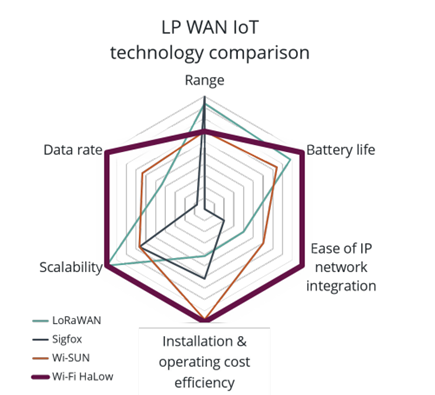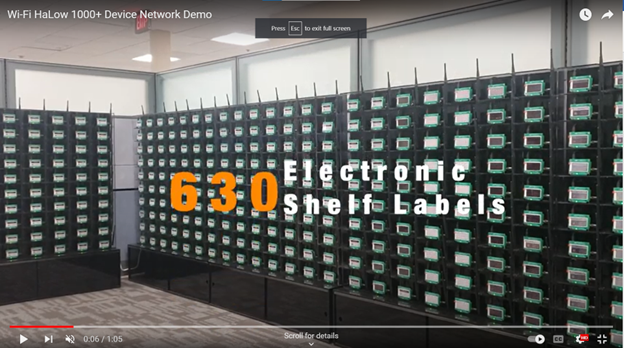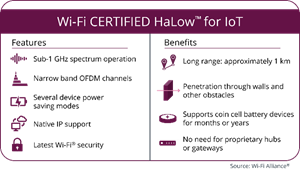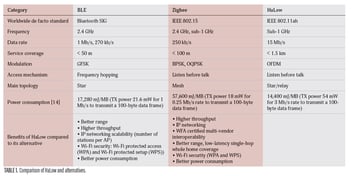A Deep Look At Wi-Fi HaLow and LoRaWAN
 When most people learn about Wi-Fi HaLow, they often inquire about how it compares to LoRa. This question drives much of the competitivity conversation as LoRaWAN is one of the leading LPWANs deployed and in use today. Previously, we have briefly explored the comparison in our Technology Disruption Poll Results blog post. While both Wi-Fi HaLow and LoRaWAN are in the LPWAN category, their differences showcase why they are both needed, and why Wi-Fi HaLow will continue to grow in use where current LPWAN technologies fall short.
When most people learn about Wi-Fi HaLow, they often inquire about how it compares to LoRa. This question drives much of the competitivity conversation as LoRaWAN is one of the leading LPWANs deployed and in use today. Previously, we have briefly explored the comparison in our Technology Disruption Poll Results blog post. While both Wi-Fi HaLow and LoRaWAN are in the LPWAN category, their differences showcase why they are both needed, and why Wi-Fi HaLow will continue to grow in use where current LPWAN technologies fall short.
What is an LPWAN
LPWAN (Low Power Wide Area Network) is a wireless network that is set up over a wide area to connect battery-powered devices, generally used for IoT deployments. The idea behind LPWANs is to have a network of devices in the field that connects wirelessly and can operate for years or months on a single battery. These networks are often connected to industrial IoT use cases and are low maintenance. LPWANs are used today to power smart cities and industries.
Wi-Fi HaLow
Wi-Fi HaLow (also referred to as IEEE 802.11ah) is a compelling addition to the Wi-Fi portfolio, making the full range of Wi-Fi capabilities an unmatched connectivity offering. IEEE 802.11ah is a new Wi-Fi standard protocol published by Wi-Fi standard group IEEE 802.11 in 2017 to offer wide-area and low-power connectivity designed for IoT applications. The Wi-Fi Alliance that drives Wi-Fi adoption and evolution has simplified the names of commonly used Wi-Fi generations with a numerical nomenclature (e.g. Wi-Fi 4/5/6) and a catchy word. Following this rule, they have named IEEE 802.11ah as Wi-Fi HaLow (pronounced “HEY-low”). The Wi-Fi Alliance also assures the capabilities and compatibility of Wi-Fi HaLow devices through the Wi-Fi CERTIFIED HaLow™ program introduced in November 2021.
LoRaWAN
LoRaWAN, placed on the LoRa physical layer, is a networking protocol designed for long-range and battery life. LoRaWAN development began in 2009 by Cycleo, which was subsequently acquired by Semtech in 2012. Today, Semtech remains the sole provider of LoRa technology. The LoRaWAN protocol introduced in 2015 provided standardization to LoRa modulation techniques. LoRaWAN is managed and developed by the LoRa Alliance, which runs a certification program and helps market the technology with the goal of driving the adoption of LoRaWAN technology.
The Basic comparison of data throughput versus range
 Source - Wi-Fi Alliance Wi-Fi CERTIFIED HaLow™ Technology Overview Whitepaper
Source - Wi-Fi Alliance Wi-Fi CERTIFIED HaLow™ Technology Overview Whitepaper
A Deeper Look at Range
 LoRaWAN is the leader in wide area coverage with a distance record of 766 kilometers / 476 miles. While that is the maximum range, a typical range is 5 km in an urban environment and 10 km in rural line-of-sight conditions according to Semtech.
LoRaWAN is the leader in wide area coverage with a distance record of 766 kilometers / 476 miles. While that is the maximum range, a typical range is 5 km in an urban environment and 10 km in rural line-of-sight conditions according to Semtech.
In comparison, Wi-Fi HaLow is marketed as having a range of 1km; however, we have observed a capability for more in our own testing. In line-of-sight tests, we reached 3 km for data communication and over 600m for HD quality video transmission with HaLow. Wi-Fi HaLow has different channel configurations and modulation techniques that can maximize range or data speeds. One of the most interesting capabilities is that Wi-Fi HaLow can also be deployed in a mesh topography for an even further range if needed.
LoRaWAN may be an ideal solution for long-range sensor-only networks, but its range and area coverage does come with drawbacks in data throughput.
A Deeper look at Data Throughput
![]() Wi-Fi HaLow offers significantly better data transfer speeds than LoRaWAN. LoRaWAN defines multiple data rates which are a combination of Spread Factor (SF) and channel bandwidth (125kHz, 250kHz, or 500kHz). LoRaWAN data transfer speeds range from 250bps in the longest-range setting to roughly 22Kbps in its fastest shortest-range configuration. At the longest ranges, it can take several seconds to transmit a 1KB message. The low speed of LoRaWAN is the tradeoff for its long range and comes at the cost of limited network scalability, high Packet Error Rates (PER), and the inability to do over-the-air firmware updates. LoRaWAN’s throughput may be sufficient for simple sensor applications but quickly runs into limitations for more sophisticated use cases.
Wi-Fi HaLow offers significantly better data transfer speeds than LoRaWAN. LoRaWAN defines multiple data rates which are a combination of Spread Factor (SF) and channel bandwidth (125kHz, 250kHz, or 500kHz). LoRaWAN data transfer speeds range from 250bps in the longest-range setting to roughly 22Kbps in its fastest shortest-range configuration. At the longest ranges, it can take several seconds to transmit a 1KB message. The low speed of LoRaWAN is the tradeoff for its long range and comes at the cost of limited network scalability, high Packet Error Rates (PER), and the inability to do over-the-air firmware updates. LoRaWAN’s throughput may be sufficient for simple sensor applications but quickly runs into limitations for more sophisticated use cases.
Wi-Fi HaLow data rates range from 150Kbps to over 15Mbps, over 600 times faster than LoRaWAN while still achieving good range. In open environments, HaLow has demonstrated over a 1 Mbps throughput at a distance of 3km. Whereas LoRaWAN can only truly handle a network of sensors, Wi-Fi HaLow can support bi-directional communication applications ranging from sensors to wireless HD Video. This has opened the floodgates of ideas and solutions for large-area IoT deployments. Commercial buildings and Industrial IoT applications have been early adopters of HaLow for use cases requiring higher throughput than LoRa was able to provide.
Other ComparisonS
Signal Penetration
LoRaWAN and Wi-Fi HaLow both operate in the sub-gigahertz range. This gives them better signal penetration over many other common wireless standards like Bluetooth and traditional Wi-Fi, meaning that locations experience better signal propagation. This advantage makes both technologies ideal for deployment in industrial areas and places with many walls or thick concrete that need better signal propagation of 900 MHz over the standard 2.4 GHz used today by traditional Wi-Fi and Bluetooth.
Battery Life
The comparison of battery life between LoRaWAN and HaLow is a complicated one. Both technologies can be low-power enough to have battery-powered devices in the field for years. If this is the only check box for you, then either one can be suitable. However, if you want to extend your device’s field life to the fullest, a deeper consideration may be required. At first glance, LoRaWAN appears to have lower power consumption when sending and receiving data. However, due to the faster speed of Wi-Fi HaLow, the time transmitting or receiving data is over 400 times quicker than LoRaWAN. Thus, HaLow’s speed becomes a benefit to reduce power consumption. The HaLow device would complete transmission and go to sleep while the LoRaWAN device would still be transmitting. If we capture this energy efficiency by measuring Bits per Joule, we can see that HaLow is over 7 times as energy efficient as LoRaWAN in Tx/Rx and yields a 50% increase in battery life.
Therefore, the choice depends on the needs of the IoT deployment. For small bits of data with sporadic transmissions, LoRa may be sufficient, but for applications that are more data-intensive, Wi-Fi HaLow is superior.
| If you want help or to be taken through a power consumption model for your IoT deployment, do not hesitate to reach out to sales@newracom.com for various scenarios and theoretical power consumption. |
High Client Count
 For simplicity, we are going to look at a single AP, but Wi-Fi HaLow and LoRa are enabled for multiple access points. On the surface, a single LoRaWAN AP can theoretically support 10,000 clients and a Wi-Fi HaLow AP can support 8,192 devices. However, with that many end clients, the AP does need the bandwidth to support the number of devices.
For simplicity, we are going to look at a single AP, but Wi-Fi HaLow and LoRa are enabled for multiple access points. On the surface, a single LoRaWAN AP can theoretically support 10,000 clients and a Wi-Fi HaLow AP can support 8,192 devices. However, with that many end clients, the AP does need the bandwidth to support the number of devices.
If you are sending just bits per day from the end device and they are all timed to transmit at separate times, you might be able to support thousands of devices with a LoRaWAN AP. However, High Spread Factors (SF) and low data rates impact the real-world scalability of LoRaWAN networks and can result in collisions, packet errors, and undelivered messages. As the number of connected devices exceeds a few hundred devices, the average packet delivery ratio (PDR) drops drastically. (see Fig.2 in the hyperlink) Wi-Fi HaLow scales more efficiently. In a realistic scenario, with over 1,000 devices you are going to want a technology that can reliably support data speeds sufficient to handle all the devices in the network. We have demoed a setup of over 1,000 devices with 630 smart labels and 370 digital displays using Wi-Fi HaLow.
While LoRaWAN is specified to be able to handle a high number of devices, the data throughput might not be enough for the amount of data being transmitted. At longer ranges, the slow transmission speed from devices can result in collisions and data loss. This increases the transmit times, consumes more power, and slows down the ability to provide real-time data. The options are to lower the amount of data throughput or reduce the range to facilitate faster transmission at lower Spread Factors (SF). Reducing the range to support the network data requirements negates some of LoRaWAN’s primary advantages. HaLow uses various Modulation Coding Scheme (MCS) mechanisms that are well-proven in traditional Wi-Fi to seamlessly optimize overall network performance. Wi-Fi HaLow can handle the high client count while helping provide real-time data and lower transmit times.
Ease of Network Integration and Ecosystem
Wi-Fi HaLow is an IP-based network and an open standard based on IEEE 802.11ah. Wi-Fi HaLow’s network implementation is built upon the same architecture that Wi-Fi is built upon. While the spectrum is different from traditional Wi-Fi, the nuts and bolts of the network are the same. This helps ease people into the network architecture and have some of the know-how already developed on how to set up HaLow networks.
LoRaWAN has the products and community developed to support new networks and designs and a certification body to make sure all LoRaWAN products are compatible and work with each other. LoRaWAN also has the maturity of time and many end devices, and sensors are in commercial products today. On the other hand, Wi-Fi HaLow is a new and growing ecosystem. Even though it does not have the current robust lineup LoRaWAN has, many industry leaders and supporters have begun committing to the development of various Wi-Fi HaLow-enabled devices and equipment to meet growing IoT demands.
Security
Both LoRaWAN and Wi-Fi HaLow have security built into the technology. Long-range wireless technologies have a larger footprint for malicious actors to connect to. LoRaWAN uses static keys and dynamically generated session keys. In contrast, Wi-Fi HaLow uses the latest WPA3 security, the same as that of the newest Wi-Fi devices, which is mandatory for Wi-Fi Alliance certification. While they both offer reasonable security measures, Wi-Fi HaLow has the more reliable security as well as the ability to remotely update devices in case any new vulnerabilities come to light.
Choosing Between LoRaWAN and Wi-Fi HaLow
While LoRaWAN may prove sufficient for monitoring low-data sensor networks over kilometers in range, the necessity for transmitting more data such as images, video, or software updates will make Wi-Fi HaLow the obvious choice. Looking at how each technology handles the number of devices, power consumption, and ease of deployment, the decision-making process may become a lot more complex. However, having the extra data throughput of Wi-Fi HaLow can help future-proof your IoT deployments.
There is a place for both LoRaWAN and Wi-Fi HaLow to coexist in the industrial IoT space. LoRaWAN and Wi-Fi HaLow invite a lot of comparisons, but the areas where they shine are vastly different.
New IoT Solutions are driving HaLoW Adoption Today
Industrial IoT manufacturers and solution providers that have higher data throughput and lower latency requirements beyond LoRaWAN’s capabilities have been the first in line to adopt Wi-Fi HaLow. These applications include IoT deployments that have remote point-of-sale devices, digital signage, and video or image capture as part of the requirements.
We have seen a wide variety of industries evaluate Wi-Fi HaLow’s capabilities, from Agriculture to Warehousing. The number of applications for the Industrial IoT that Wi-Fi HaLow enables is staggering and interesting. Wi-Fi HaLow is filling the gap between LoRaWAN and Wi-Fi. If you have had any ideas that LoRaWAN did not support, take a good long look at Wi-Fi HaLow. Reach out to us at sales@newracom.com and learn if HaLow is a good fit for your application.




